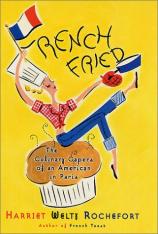French Fried: The Culinary Capers of an American in Paris
Review
French Fried: The Culinary Capers of an American in Paris
![]() "Can
"Can
anything prepare an American woman for life in France and in
particular the life of the wife of a Frenchman who is used to
eating the French way? My short answer to that one is: no. The
French way, I can assure you, is not the American way. If you want
to know what the difference is, get a group of French and Americans
together and stick them on a desert island… The main
preoccupation of the French group will be what they will eat and
when. The American group won't think about food other than as an
afterthought."Harriet Welty Rochefort did what most of us only dream about
--- she moved to Paris and has spent the last 30 years living in
the City of Light. In her first book, FRENCH TOAST, she talked
about the pleasures and frustrations of adjusting to life the
French way.Now,
in FRENCH FRIED, Harriet details her odyssey from culinary novice
to a competent cook turning out two three-course meals every day.
She tells us, "In those early days, I couldn't quite fathom that
most of the next two decades of my life would be spent on that
earthshaking but necessary question: What are we going to eat?" As
Harriet details her experiences, she sheds light on what is perhaps
the single greatest difference between Americans and the French:
the relationship each of our cultures has with food --- differences
that are as vast as the ocean that separates the two countries. In
a nutshell, the French view food as a pleasure while Americans view
it mostly as a necessity. But, as she points out, even though the
French view food as a pleasure, "there are rules for the way you
make food, but also the way you serve food, and even the way you
talk about food." In other words, there is no counting calories, no
slapdash meals, no barbecues…and no pumpkin pie.What
makes this book so interesting is not just learning about the
cultural differences in regard to food --- the French rarely eat
sandwiches, never issue casual dinner invitations, and 80% still
return home for lunch every day --- but the lengths Harriet goes to
illustrate her observations. She takes cooking classes, calls on
experts and even explores a dark, damp cave beneath the city where
hundreds of varieties of cheese are stored --- the ideal place for
mold to grow to make the cheese its tastiest.Not
being an enthusiastic participant when it comes to trying new foods
(this is something I'm working on!), I'm in awe of culinary
adventurers like Harriet. If there is one "lesson" to be had from
this book it is to keep an open mind when it comes to food and to
try something at least once. That said, Chapter 7 --- which is
titled "Body Parts or: Is offal awful?" --- is not for the faint of
heart. She spares no details about how blood sausage is made, why
fresh rabbits are sold with their heads on (during the war cats
were substituted for rabbits, so this way you know what you're
buying), which parts of a pig's ear to eat, and the various ways to
cook a boar's head --- one of which is civet de joue, a red wine
stew using the blood.Much
more appetizing are her stories about meeting and discussing
chocolate with Robert Linxe, owner of the world-famous Maison du
Chocolat; drinking wine with Gerard Margeon, the chief wine steward
at six-star chef Alain Ducasse's Paris restaurants, with whom she
attends a private tasting at the Ritz; and cooking and dining with
the Rochefort family at their country home in the village of
Bréchamps.The
lively, first person narrative and breezy, conversational style
make for easy reading. Combined with Harriet's sense of humor,
family recipes, and historical facts on everything from the
baguette to winemaking, you feel as if you're talking to a friend.
Her writing is very visual and evokes a sense of place whether
she's at the market, Le Cordon Bleu cooking school, or her own
kitchen.There are some practical tips for those who may be planning a
trip to France. For example, don't expect to eat a typical American
lunch in a restaurant. For lighter fare such as a salad or an
omelet, go to a brasserie. But beware --- even in a brasserie you
should avoid tables with white tablecloths, which indicate that you
want a traditional French lunch. There is also advice on things
like tipping, sending back wine, and when to drink coffee (it's
served as a separate course after dessert).For
anyone with an interest in French culture, who loves food, or who
simply enjoys good storytelling, FRENCH FRIED is worth the trip.
It's armchair travel at its best, a book that not only inspires
fantasies of visiting a far away place but one that truly
encourages you to expand your horizons. And who knows --- when I
take my next trip to France I just might try the civet de
joue.
Reviewed by Shannon McKenna on January 22, 2011
French Fried: The Culinary Capers of an American in Paris
- Publication Date: March 7, 2001
- Genres: Nonfiction
- Hardcover: 272 pages
- Publisher: Thomas Dunne Books
- ISBN-10: 0312261497
- ISBN-13: 9780312261498



